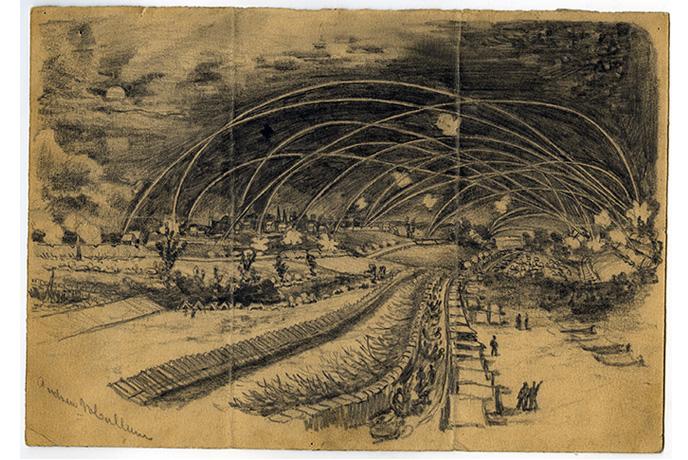First Hand

Civil War-Era Drawings From the Becker Collection
by Michelle Simmons
In 1900, when Joseph Becker retired from his four-decade career with Frank Leslie's Illustrated Paper, he took with him nearly 700 original drawings that he and other artist-reporters had produced since the 1860s, most notably of the American Civil War.
The war was one of the first major conflicts covered by the newly emerging medium of illustrated newspapers such as Leslie's and Harper's Weekly. Combat illustrators, known as "special artists," prepared drawings of various aspects of warfare and camp life and shipped them to their editorial offices, where the images were engraved and paired with news articles.
On June 7, The Trout Gallery, in collaboration with Archives & Special Collections, opened First Hand: Civil War-Era Drawings from the Becker Collection with 51 of those drawings and corresponding illustrations from Leslie's, illuminating the origins of what we today call embedded journalists.
The "special artists" endured many of the same dangers and privations as the subjects of their sketches. In a letter accompanying his drawing of the bloody two-day Battle of Shiloh, Henri Lovie noted, "I commenced on the extreme left wing, and visited every division, obtained guides, listened to all stories from all sides, and made upwards of 20 local sketches of positions and scenery, including all the battle-grounds—there were many—and send them to you in something like their logical and chronological relation, a task of no little difficulty."
Some of the more intriguing elements of the exhibition, says Phillip Earenfight, director of The Trout Gallery and associate professor of art & art history, are the mid-19th-century technological innovations—from steam engines and railroads to the rotary press—that allowed the artists to quickly convey their sketches to editorial offices in New York City, where a stable of engravers re-created the images (and often reinterpreted them) for mass production.
On the following pages are some of those sketches, their accompanying illustrations and portions of the exhibition's narrative. The exhibition runs through Oct. 19, and a reception will be held Aug. 30, with guest lecturer Harold Holzer, writer and leading authority on Abraham Lincoln and the political culture of the Civil War era.
Running concurrently with First Hand is Carlisle & the Civil War, an exhibition that focuses on how the Civil War affected the lives of Carlisle residents and Dickinsonians. Drawing from material organized and published by Dickinson's House Divided Project in collaboration with Archives & Special Collections, the exhibit provides intimate views of a war that pitted Pennsylvanians and Dickinsonians against each other over a range of conjoining issues, from slavery and abolitionism to nationalism and expansionism.
Published July 24, 2013